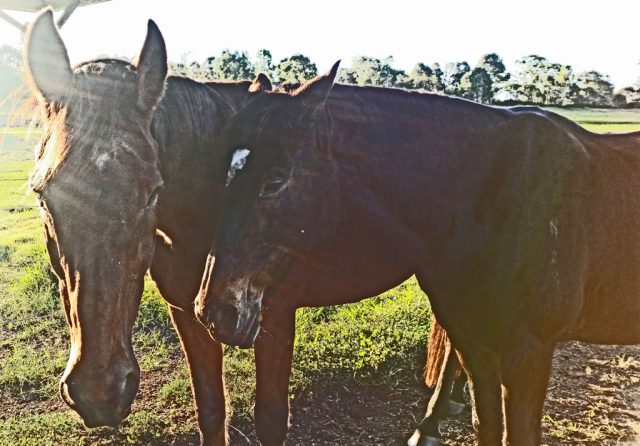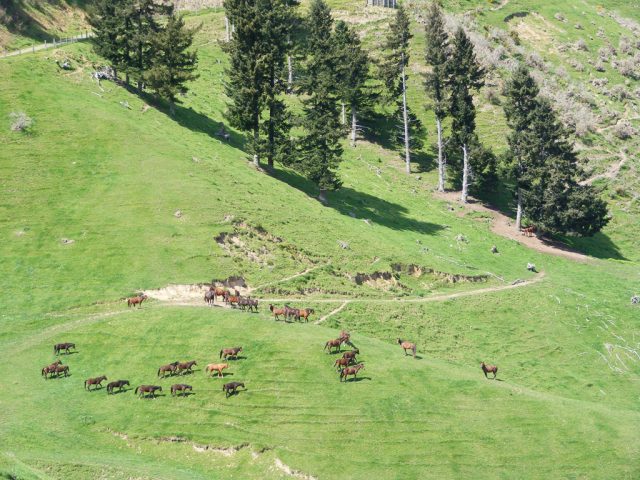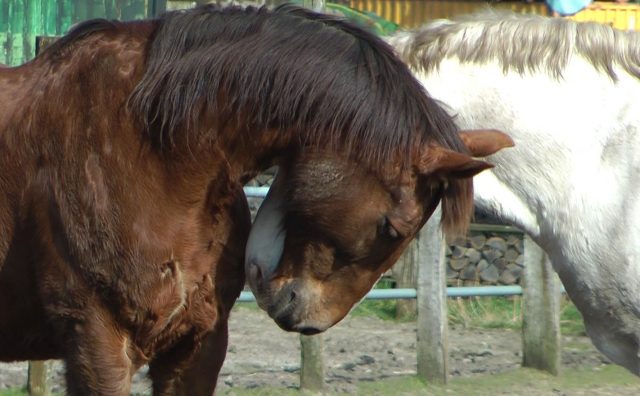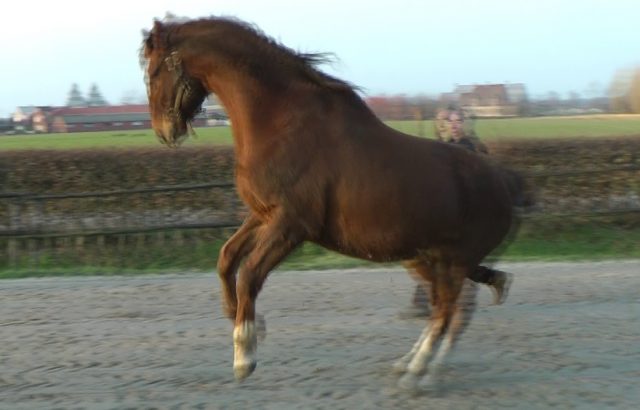A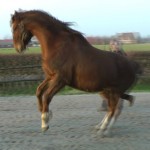 lthough the energetical nature of the horse appears to me as something which is so utterly obvious and self-evident, I have yet to come across its mention in any ethological study of horses in the wild in spite of the fact that it is so clearly present in the audio-visual documentaries dealing with the subject matter. For this reason most of my observations and conclusions are based on my experience with horses in captivity, albeit in situations which in some small way seek to emulate the horse’s natural habitat.
lthough the energetical nature of the horse appears to me as something which is so utterly obvious and self-evident, I have yet to come across its mention in any ethological study of horses in the wild in spite of the fact that it is so clearly present in the audio-visual documentaries dealing with the subject matter. For this reason most of my observations and conclusions are based on my experience with horses in captivity, albeit in situations which in some small way seek to emulate the horse’s natural habitat.
If you have access to a group or herd of horses, you can learn much about their energetical nature by watching them communicate with each other. Like me, you will probably have been told that horses communicate with each other using body language. While this may be true to a certain extent, does this represent the full picture? We have learned that certain subtle movements mean certain things but do they really do so on their own? For instance, you are probably aware that when a horse moves their ears back, they may be giving a warning. Yet horses do the very same thing when they doze. And when we see a horse perking up their ears, we tend to conclude that they are content, yet they also do this when detecting potential danger and preparing to flee. Clearly the same sign may have not only different but even opposite meanings. So how do we know which one applies? The energy with which the sign is expressed, surely?
Energy and intent
But let me play devil’s advocate. It could be the context in which it occurs rather than the energy behind it, couldn’t it? After all, the dozing horse is calm, while the creature flashing a warning is strident. Yet is this not indicative of the energy behind the sign? After all, if the horse flashing a warning was not strident but instead exhibited the energy of dozing within the context of warning, would anyone really take that warning seriously? Indeed, there are times when a horse need not even move their ears back to issue a warning. A look may be enough. We know this too from our observations of horses. Again though, is it not the energy that is communicated through the horse’s presence and actions, however subtle they may be, which ‘speaks’, as it were?
As always, intent is the driving force of the energy with which a horse expresses themself. Intent determines the nature, intensity and direction of such energy. As such, the energy with which a horse expresses themself communicates their intent through the form of that expression. It is precisely this use of energy which explains why horses are able to communicate with each other using signs which are sometimes so subtle that they are barely noticeable. The hardening of the eyes is an example of this.
Energy and physical contact
The nature of horses as energetical beings is particularly evident in their interaction with each other and members of other species. This is especially true in relation to their response to what they perceive to be physical pressure and what they treat as an energetical request or demand. Horses are hardwired to respond to what they perceive to be physical pressure (and this can vary somewhat from one horse to the next) by resisting it. If we push, they push back and if we pull, they pull back. These are reflexive responses and the energy with which they are expressed is precisely that, reflexive. This may of course change. In a particular situation the energy may turn to that of panic, for instance, where a horse at the end of a lead rope frantically realises that they cannot escape and blindly starts to thrash around. Alternatively, the horse may realise this and resort to resistance and even attack. This energy is very different from that of panic.
The type of energy with which any action occurs is arguably as, if not more, decisive than the body language employed to articulate it. For instance, horses may treat a sharp slap or smack very differently depending on the situation in which it occurs. Because it descends upon them at speed and with force, they are likely to perceive it to be threatening and may start moving away from it before it lands, hence, before any physical contact occurs. But will they do so if our energy is not threatening but concerned? Let us take slapping as an example, and here I am referring to a pretty hard slap anywhere on the horse’s body with the exception of the head and between the hind legs. What would normally happen if you were to slap your horse nice and hard? They would move away, would they not? Of course they would but only if they perceive the energy accompanying the slap to be threatening.
What if I were to tell you that I slap my horse and not just mine but my partner’s too? What if I were to tell you that my partner slaps her mare and mine too? And what if I were to tell you that both mares come to us when they want to be slapped and position their bodies in front of us, so that we can deliver the slap to exactly where they require it? Actually, our horses do not normally do this. They only do so in the warmer months when horse and other flies descend upon them, reducing their lives to fly-bitten misery. Even when wearing fly mesh, there are still occasions when a horsefly alights on the mares’ thin summer coats and the only sure way of liquidating it is to slap it smartly. Our horses know that we are helping them when we do this and they are willing to accept the slaps – and even beg for them – if this is what it takes to eliminate the pests. And how do they know? By the words we speak? By our energy? If not by our energy, what then?
Energy without physical contact
Then there is the energy which accompanies physical contact but without any physical pressure being exerted. This type of energy I discovered entirely by chance while trying to ask a horse in my care to raise their head from their pile of hay to allow me to clean their eyes (I preform a good deal of physical care while the horses eat, as they seem to be much calmer and more amenable). Describing how I do this may perhaps illustrate what I mean more graphically than an abstract attempt at explanation. Essentially, I place my hand under the neck or jaw of the horse while standing just to their side. Fully present in the moment, I suddenly stand up erect, all my energy and intent directed at ensuring that the horse raise their head but my hand below their neck or jaw, while remaining present, does not itself exert any physical pressure and merely serves as a conduit for the energy. This action I might accompany with a verbal request, such as ‘Head up’. Although I do not usually need to employ this technique as the horses habituate themselves quite quickly to routines, it does illustrate horses’ sensitivity to energy and the resultant difference in their response to the physical contact.
Where energy is not accompanied by physical contact, horses tend to respond differently on the whole. Instead of resisting such energy, they appear to be more inclined to yield to it and to do so far more readily than in the case of physical contact, provided that the source of the energy is a creature who has presence or inspires fear. In this case too the reason is quite straightforward in that it lies within the nature of horses to do so. All too frequently we humans trot out the trite mantra to the effect the horses are creatures of flight. When faced with a perceived danger, they almost instinctively seek to flee first. Well this is precisely what explains in part why they are likely to yield to such energy in the absence of physical contact, especially if it is perceived to be that of an actual or potential threat.
Energy and focus
Horses also appear to respond very differently to contact-free energy, depending on whether they perceive it to be focused on them or not. Indeed, it is precisely this distinction which is so clearly discernible in herd behaviour. By way of an example, in one of the ‘herds’ in which my mare, Pip, spent part of her life there were two geldings, a heavily built Dutch warmblood gelding called Bentley and a grey Polish quarterhorse dubbed Duke. At the top of the pecking order (this was an arbitrarily chosen ‘herd’ in captivity), Bentley could pass calmly through the herd without causing any consternation and any horse in his path would defer to him and move out of the way with a similar degree of calm. All the other horses acknowledged his status as the dominant (as in further up the ‘pecking order’ as opposed to dominating) presence in the herd and yielded to that presence in the knowledge that any pressure which they may have experienced was not directed against them.
Duke, on the other hand, was an aggressive, maladjusted individual who felt a constant need to charge any horse that he felt was entering his rightful domain or was close enough to do so. As a result, all of the other horses with exception of the acknowledged ‘leader’, Bentley, were frequently sent scattering, almost always creating potentially dangerous situations. Duke directed his aggression towards his herd mates and they responded by ducking out of the way and rushing off to escape his perceived reach. Instead of simply moving out of his path, as they did with Bentley, safe in the knowledge that no aggression was being directed towards them, they immediately felt Duke’s focus on them and responded accordingly.
It is precisely this difference in focus, this indirect energy (the energy being directed towards the path, as it were, and not against any horse obstructing it) which lends itself to creative interaction with horses. By assuming the energetical presence of a creature with presence, hence one who does not entertain any doubts about that presence and who therefore has no need to resort to dominant behaviour, it is possible to indirectly induce a horse to acknowledge our presence and ultimately choose to follow it. Those humans, on the other hand, who fail to acknowledge this important difference in focus are left with little choice but to adopt the presence of a Duke, securing compliance through the threat of force. And like Duke, the source of such aggressive behaviour ultimately lies in impotence. Powerless in the absence of any meaningful alternative, the human resorts to unsocial behaviour towards one of the most sociable creatures on the planet.
I find this indirect energy particularly useful when distributing hay in a small ‘herd’ of horses. Sometimes holding my hand higher than and in front of my head to create the illusion of a ‘bigger me’ with the hay held in my other arm away from the horses, I move determinedly through the herd without looking at any horse directly and they generally back or turn out of the way, although on occasion I may need to motion them away with a slight but ‘intentful’ (full of intent – a word waiting to be invented) wave of my erect hand.
Oblique energy
There is another form of energy in the absence of physical contact which horses respond to without feeling threatened. I call it ‘oblique’ energy, as it is a combination of aspects of direct and indirect energy. In this case the energy is directed at the horse but without facing the animal or looking them in the eye. Although the horse is aware that they are being challenged, they do not experience this type of energy as threatening, because it does not appear to be directed at them personally, as it were. I find this form of energy particularly useful for asking a horse to reconsider their decision to abandon their pile of hay to chase a fellow species member away from theirs because they perceive it to be bigger or better. In this case I position myself between the dominant horse (as in higher up the ‘pecking order’ at that particular point in time) and the subordinate animal (as in lower down the ‘pecking order’ at that time) and respond to every step of theirs with one of my own, blocking access to the other pile of hay. Calmly and patiently we conduct our little dance, until the message sinks in and the dominant horse returns to their own pile of hay.
Ultimately, all these forms of interaction with the exception of physiological reflex responses are expressions of energetically laden behaviour. In the absence of any restraints or instruments of compulsion, a horse with presence relies predominantly on the energy of their intent when interacting with other members of their species. Other horses respond energetically to the energy which they sense. It is this creative use of energy which defines the energetical horse and nowhere is this more clearly illustrated in the horse than in their capacity for cohesion and synchrony.
Cohesion and synchrony
Cohesion refers to the tendency of horses to move together, especially when doing so at a pace in excess of more than just walk, particularly at a canter or gallop and to do so dynamically. When they move in this way, they edge close together but without jostling each other, even at speed. Clearly this requires a particularly finely tuned sense of other horses’ energy. Analyses of video footage of wild horses fleeing a predator reveal that in such a situation the herd appears to act as a unit, much like a shoal of fish, capable of switching direction at any point through any of the creatures involved even in the frenzy of flight. This they manage to do without colliding with and crashing into each other. Again, this suggests that horses are not only keenly aware of each other’s energy but are also able to respond to it instantaneously.
Closely tied to such cohesion is the horse’s innate predilection for synchrony. In its most basic form, synchrony denotes simultaneous action, movement or occurrences. In the horse it is most clearly discernible in the natural way in which horses move together, whether in walk, trot or canter, or at the gallop. Such movement occurs in unison or so it seems, even where a change is suddenly evident in their pace, direction or equilibrium. As noted in relation to cohesion, any horse moving in synchrony with another may initiate such a change, even in a herd in flight. The horses gallop together as though they comprise a single living creature, even though their pace, direction and energy level may be altered en masse simply by virtue of any one of their number initiating such change and the rest following suit. It is this capacity for interactively altering synchrony that I wish to reflect in the use of the term, ‘dynamic’. In horses dynamic synchrony refers not only to the movement of horses in synchrony with each other but also to their ability to influence its nature – pace, direction, energy level and so forth – dynamically.
The horse’s innate energetical nature, could it not be of profound significance to those of us humans who find joy in interacting with them? Does it not also imply that, if another living creature is capable of being influenced by the horse’s energy, that we might similarly be capable of doing so if we learned to be open to that energy? Does it not suggest as well that such a being might also be able to influence the horse’s energy by using their own to do so? And given humans’ extensive knowledge and experience of shaping personal energy, especially in Eastern experiential disciplines and more recently in the West’s growing embrace of such practices, does this not point to an avenue which has the potential to completely transform the dynamics of interaction between horse and human if we only learned how to harness our own personal energy?
(Taken from the third draft of the book, Being Humans for Horses. Click here for more information.)
Equine Touch
Our Equine Touch business is called Humans for Horses, you can find our website at:
http://www.humansforhorses.com/
and our Facebook page at:
https://www.facebook.com/Humans.for.Horses
Horses and Humans on Facebook
May I remind you that we now have a Horses and Humans group on Facebook. If you would like to leave a comment, you can do so on this blog or on the the Horses and Humans Facebook group page. All new posts will feature on that page along with additional content posted by any of our members. Please feel free to join us at:
https://www.facebook.com/groups/horsesandhumans/
There is also a Horses and Humans publications page, which contains information concerning the publications released under the Horses and Humans imprint. Some of those publications will be free of charge. You will find it here:
https://www.facebook.com/horsesandhumans
I also have a Facebook page through which you may contact me. You will find it at:
https://www.facebook.com/andrewglynsmail
